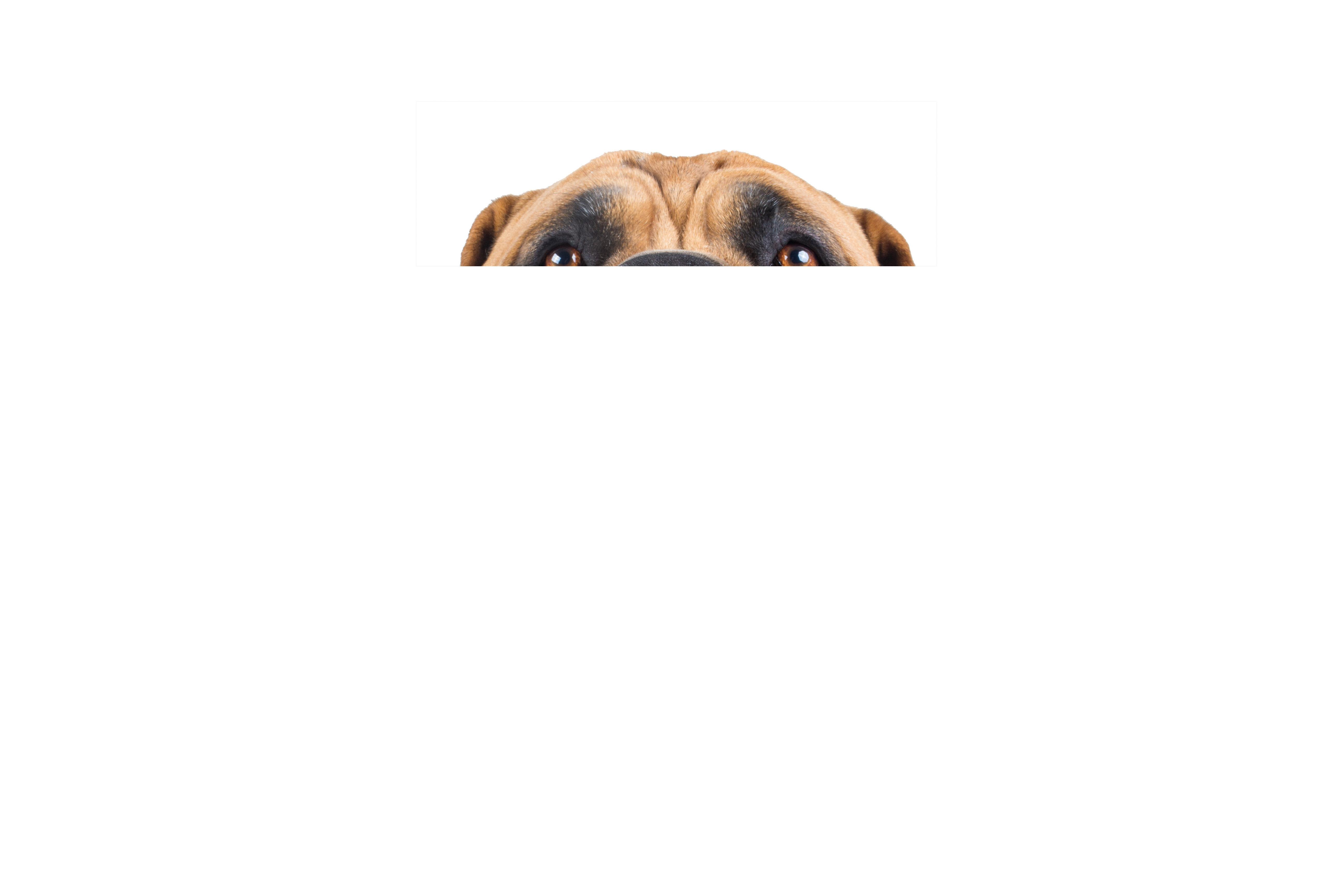






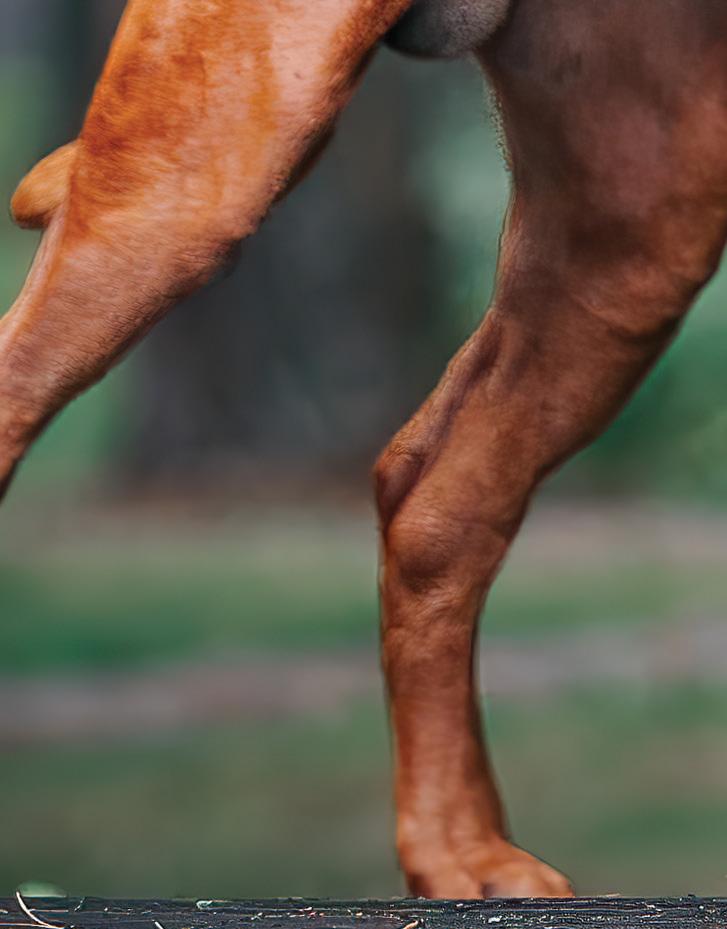

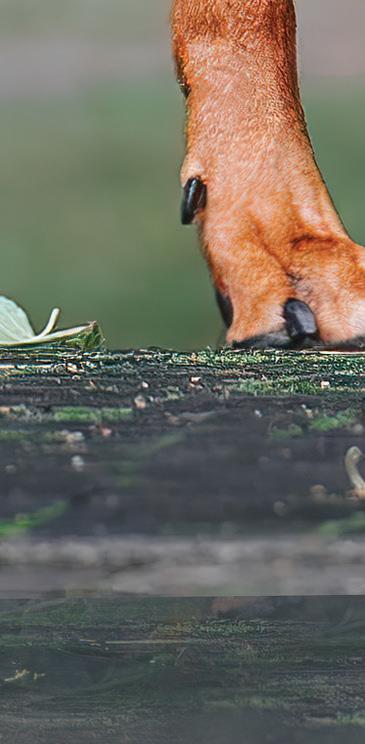
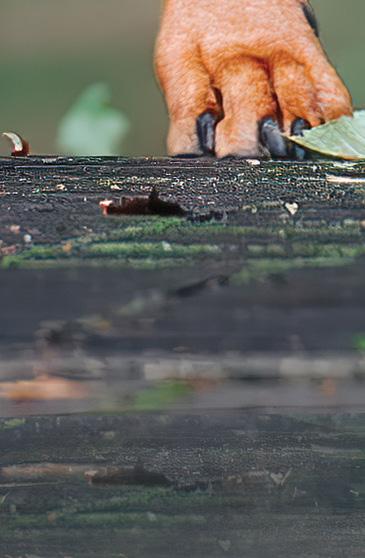
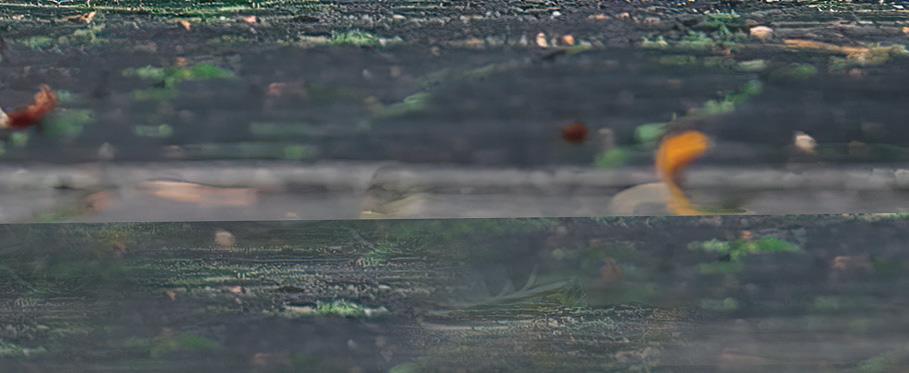









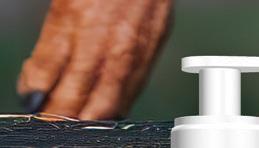

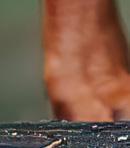


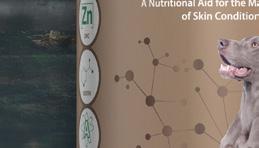
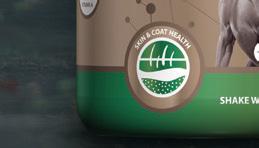
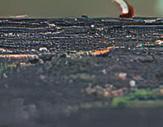






















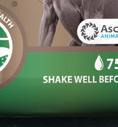

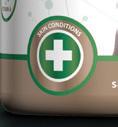













































































































































































































































































Welcome, dog-lovers!
We’re back again with another pooch-packed edition of DQ Magazine.
With Christmas songs already playing in the shops(!), we felt it was a good time to include some festive features in the magazine. From planning what to do with your companion if you’re going away to fun activities to take part in together if you’re planning a staycation, we’ve really got you covered.
Next issue will be our big Christmas special, packed full of fun, but this issue is all about planning and getting ourselves ready for a canine Christmas. We know there’s already lots of chat in the office about dog stockings, Fido’s favourite treats for Christmas and which doggy hotel to book into, so we figured the content would be helpful for everyone! We hope you agree!
Of course, we also have our usual features such as our breed of the month (the breathtaking Boerboel), our Q&A section and our exercises from the very wonderful Animal Health and Hydro Team, so if you feel like Christmas is just too far off to contemplate, there’s something here for you too.
As always, before closing out this Editor’s Note, we’d like to thank our generous advertisers who, through their support, are allowing us to make this magazine freely available to the dog community across southern Africa. We couldn’t do it without them, so please support them where you can!
We’ll see you back here next time, but until then, enjoy this issue and give your doggies a scratch from us!
Lots of love,
DQ | 3C 3
Dr Lizzie Harrison | Editor
Lizzie and the DQ team xxx
Designer: Anne Royden-Turner
The views expressed in DQ are not necessarily those of Magda Media and the acceptance and publication of editorial and advertising matter in DQ does not imply any endorsement or warranty in respect of goods or services therein described, whether by DQ or the publishers. DQ will not be held responsible for the safe return of unsolicited editorial contributions. The Editor reserves the right to edit material submitted and in appropriate cases to translate into another language. DQ reserves the right to reject any advertising or editorial material, which may not suit the standard of the publication, without reason given.
DQ | 3C 4 IN THIS ISSUE DIGITAL ISSUE 3C | 2022 06 The Boerboel This heavy dog breed is a staple in many SA homes 14 Your dogs Meet Sue and Orion 16 Dogs are the best And here’s why 24 Holiday season What to do with your dog when you go away 28 Festive fun loading Fun things to do with your dog 36 Fence fighting How to minimise it in your home 48 Dog training How to find a suitable class 54 Basic exercises for your dog Part 4 58 Degenerative myelopathy A devastating spinal condition 62 Let sleeping dogs lie Understanding sleep in our canine companions 66 Ask DQ Your dog questions answered 70 Products we love
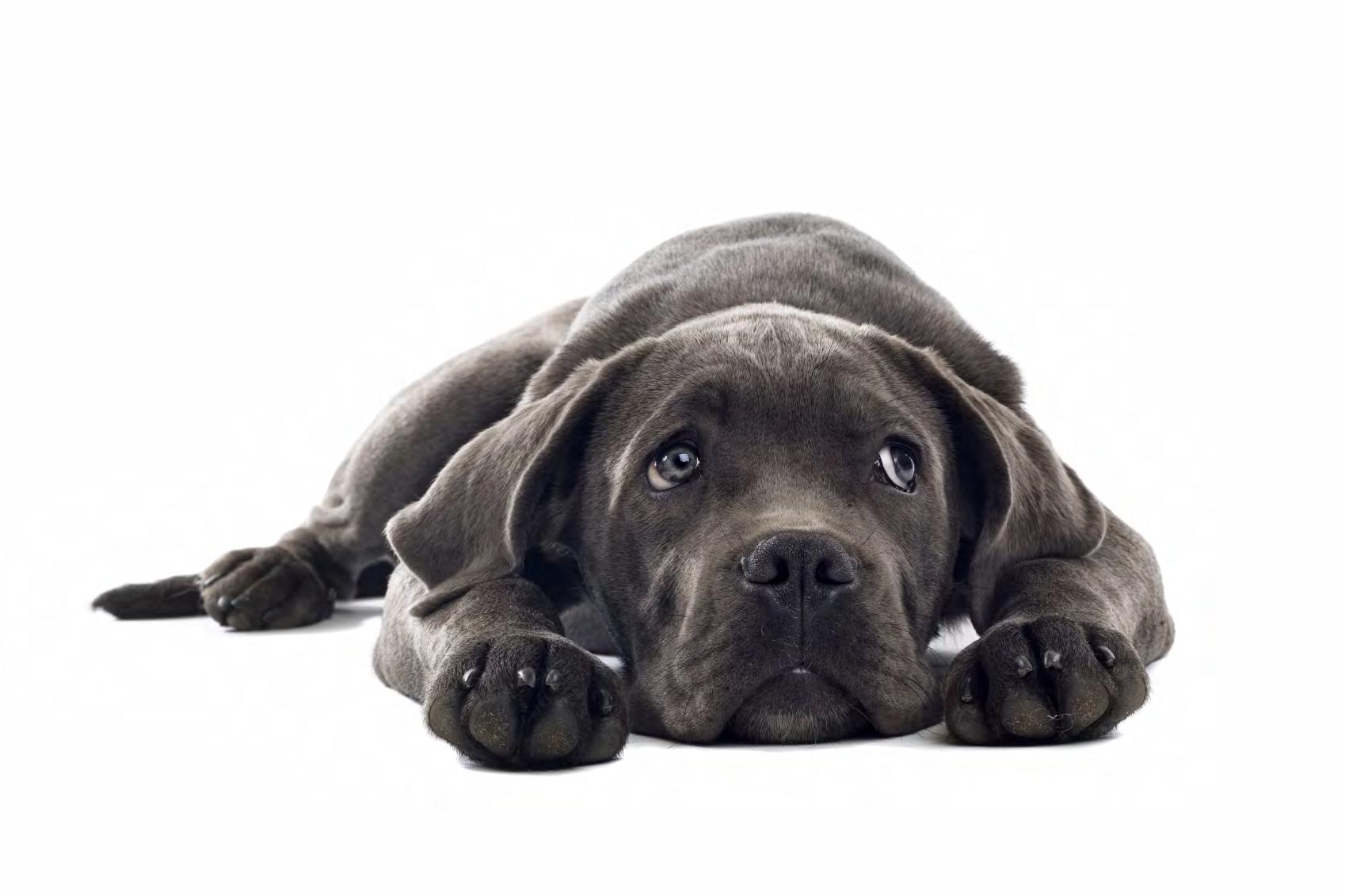

DQ | 3C 6 BREED PROFILE
TEXT: RHIANNON CECIL
The Boerboel
THIS HEAVY DOG BREED IS A STAPLE IN MANY SOUTH AFRICAN HOMES
DQ | 3C 7
BREED PROFILE
This month, we're back to big dogs with the home-grown South African Boerboel. The Boerboel, an Afrikaans word for 'farmer's dog', is, in many ways, South Africa's answer to the Bullmastiff. These massive brown dogs, with their distinctive black faces, were originally bred as security dogs for farms and diamond mines. Although they are still used in this capacity, the breed has evolved over the years, and, in the correct homes, they make great family dogs.
BOERBOEL HISTORY

The Boerboel's ancestors can be traced back to the nowextinct Bullenbeisser dog, a breed which accompanied European explorers, including Jan van Riebeeck to Africa in 1652. Some centuries later, the De Beers of diamond mine fame imported some of the world's most formidable Bullmastiffs to patrol some of their mines. Modern Boerboels, even at a glimpse, are almost identical to the Bullmastiff in many ways.
These imports, along with their longer legged bulldog cousins, helped cement the Boerboel into the stand-alone breed we see today - about fifty percent mastiff and fifty percent bulldog. But who's counting?
As the breed began to come into its own, South African farmers began to use them more and more as family protection dogs, and many of the Boerboel lines we see today have come about as a result of natural selection; those dogs who could withstand the rigours of the lifestyle were used in breeding. Today, the breed is robust, hardy, and an excellent protection dog, though they have to be managed according to their massive size (males can weigh up to 80kgs) and tendency to be territorial.
DQ | 3C 8
BREED PROFILE
A BOERBOEL OVERVIEW
Despite their size, Boerboels are agile and athletic working dogs. They are confident and loyal to their family, though they can be suspicious of strangers. They are bred as protection dogs, and this trait is dominant in many modern breeding lines. However, they love to be part of the family and aim to please. They can be playful and affectionate, and you may find yourself with an 80kg lapdog if you're not careful.
Because of their tendency to be protective and their sheer size, they're not recommended as dogs for first-time dog owners, nor are they ideal for apartment living. They can be
lazy and relaxed but still need space to move and an outlet for their goofy energy.
They have short, dense coats that require minimal grooming, which is great, and if socialised correctly, they are likely to get along well with children and most household pets.
LIVING WITH A BOERBOEL
A Boerboel is essentially a guard dog, and a family dog all rolled into one big jowly ball. They will be happy playing with the kids, but woe betides a stranger who happens to walk into your yard. Even a friend may be at risk, and


DQ | 3C 9
BREED PROFILE
care must be taken to introduce the breed properly to guests. If a Boerboel feels a member of his pack needs to be protected, make no mistake, he will be aggressive. For this reason, interaction with children should always be supervised, lest he misinterprets something. But don't let his hardcore reputation fool you; he is a cuddle bunny underneath it all, as long as he understands everyone's intentions.
Boerboels can be comical and dorky when relaxed and feel like part of your family. Beware of breakable objects on coffee tables, as they tend to be clumsy at the best of times. Despite their dopey demeanour, they're actually intelligent dogs with lively minds. As long as training is approached methodically, they are obedient and eager to please.
Boerboels also eat a LOT, so be prepared to spend more than the average amount on dog food. And, as an added warning, Boerboels can be gassy, so make sure you open the windows, and you'll be safe and comfortable with him lying on your feet (or your lap).


DQ | 3C 10 BREED PROFILE

DQ | 3C 11 BREED PROFILE
BOERBOEL HEALTH
This breed is designed to be hardy, and as a rule, there are no Boerboel-specific health problems to look out for. Large dog breeds are prone to hip and elbow dysplasia, however, and the surge in popularity of the Boerboel has created breeding situations in which this debilitating problem isn't addressed. If you're looking at getting a Boerboel, please make sure a vet sees his hips and elbows before you take the plunge.
With Boerboels, you must also be on the lookout for bloat (when the stomach fills with gas or food and then twists). Bloat is fatal if left untreated and, unfortunately, common in large-breed dogs.
IS A BOERBOEL THE RIGHT DOG FOR YOU?
A Boerboel might be the right dog for you if:

• You're looking for a scary guard and goofy family dog all in one.
• You have older children in your home.
• You'd like a large, intimidating-looking dog, and you don't mind him knocking over the occasional coffee mug.
• You want an affectionate dog to be part of the family.
• You have a large, fenced-off area for your dog to play in, and you're happy to take him on walks.
• You are willing to take part in socialisation and puppy training.
• You love having a large, strong dog to play rough with and also cuddle at night.
DQ | 3C 12
BREED PROFILE
garden.
• You've never owned a dog before. A Boerboel is not an ideal dog for first-time dog owners.


• You're looking for a dog who is completely relaxed with visitors.
• You don't like cleaning up drool.
time to train and socialise, they will really be the lover and protector of the family, a truly solid citizen who'll keep you warm and very safe at night. Boerboels are a lot, though - there's no doubt. So make sure you have the time and patience to deal with them, and at the end of the day, you'll always have a devoted member of the family at your side.
DQ | 3C 13
BREED PROFILE
Meet Sue and Orion
DQ : What is your dog’s name? Sue: My dog’s name is Orion – he’s the “O” in JOY Dogs.
DQ : Hold old is your dog, and how long have you had him? Sue: He is four years and four months old. I have had him since I imported him from Russia at four and a half months old.
DQ : Does your dog have brothers or sisters? Sue: He has two sisters – Jade and Yola. They make up the J and Y of JOY Dogs.
DQ : What is your dog’s favourite treat? Sue: His favourite treat is biltong.
DQ | 3C 14
YOUR DOGS
DQ : Does your dog have any hobbies or activities he takes part in?
Sue: He loves skateboarding, showing off tricks (he can read and tell his age) and going out as a member of the JOY Dogs to make people smile.
DQ : What makes your dog unique?
Sue: He has personality PLUS and is a rare breed. There are only about 40 of his breed in South Africa, and he is the brand mascot for Dulux Paint.

DQ : Why should your dog be DQ famous?
Sue: We want to spread the word about the JOY Dogs and make everyone smile.
ABOUT JOY DOGS
JOY Dogs has been serving the educational sector since 2011. Their mission is to educate learners about responsible pet ownership and safety around dogs. They believe that the best way to achieve this goal is through teaching children about dogs from a young age so that they grow up to be responsible pet owners. Check out the wonderful JOY Dogs here www.joydogs.co.za or follow them on Facebook https://www.facebook.com/ JOYDogs
DQ | 3C 15 YOUR DOGS
TEXT: RHIANNON CECIL
DOGS ARE THE BEST
…AND HERE’S WHY…
Thinking of getting a dog? Whether you already have a dog or are looking to get one, remembering why we have them is never a bad thing. Dogs do so much for us, so reminding ourselves about exactly why we love them so much seems like a perfect early Christmas present to us here at DQ.

DQ | 3C 16
DOGS AT HOME

DQ | 3C 17 DOGS AT HOME
DOGS KEEP US HEALTHY
Our dogs have a positive impact on our physical well-being. They don't just make us less stressed, either. They do a lot more than that:
• A dog sleeping in your bed has been shown to give you a more restful night's sleep. Though previously thought to have been disruptive, recent studies have shown the opposite to be true, as long as your dog doesn't sleep on top of you.
• Children who grow up with dogs have fewer allergies, ear infections, and asthma. They are also more active when playing with their four-legged buddy and spend more time outdoors.

• Dogs have been known to reduce cardiovascular complications in older adults, so having a dog literally means you have a healthier heart.
• Dog parents are up to four times more likely to reach their daily exercise goals. Going to the gym may be
DQ | 3C 18
DOGS AT HOME
optional, but walking the dog often isn't.
• You live longer when you have a dog. Studies conducted between 1950 and 2019 showed that having a dog reduced the risk of death in many cases. Dog owners have lower blood pressure and better responses to stress, which makes for a longer life.
• Dogs help our brains function better. Canine-assisted therapy has been shown to have an extremely positive

DQ | 3C 19
DOGS AT HOME

DQ | 3C 20
impact on cognitive functioning in older adults, so there's no reason to believe we wouldn't reap the benefits at all ages.
• People who have dogs recover more quickly from serious illness and injury than non-dog owners - whether it's down to the cuddling or the company doesn't really matter.
DOGS KEEP US SOCIAL
While we know we're bonding with our pooch, we may not have known that he, in turn, is helping us to form meaningful connections with other human beings. Dogs can even help us meet our soul mates. No matter how old you are or where you come from, your dog will play a big role in your social interactions overall:


• Up to 40% of dog owners find it easier to make friends compared to those without a dog. With dogs, you always have something to talk about!
• Having a dog makes it more likely your friend will visit you at home. Not that you have to have people over
every weekend, but it's nice to have the option if you want it.
• If you're looking for the love of your life, pay close attention. A man with a dog has a better chance of getting a woman's number than a man without one. Singles are also more likely to swipe right on profile pictures with a dog in them on dating apps. Make sure it's your dog in the picture, though, or you might end up with one disappointing date.
• Dogs can help children with autism and social anxiety form meaningful connections with others.
• Children who grow up around dogs have been known to show a higher degree of empathy.
DOGS KEEP US SANE
• Spending as little as fifteen minutes with a dog is proven to boost your mood and lower your stress levels, so having a dog in your life makes it much more likely you'll start your day with a smile.
DQ | 3C 21
DOGS AT HOME
• Dogs pick up on our feelings and often react perfectly, giving us a shoulder to cry on and a warm hug or a good play when we need it the most.
• We genuinely get happier when we look into a dog's eyes. A study in Japan found that looking into a dog's eyes increased oxytocin levels in their human counterparts. Oxytocin is also known as the love hormone – need we say more?
• Having a dog reduces the risk of loneliness. Social isolation is real, especially since the COVID-19 pandemic. Dog ownership has been proven to reduce loneliness in as many as 85% of dog owners.
• People with dogs have been shown to have better self-esteem, and who says no to feeling better about yourself?

• Being around dogs reduces our cortisol (or stress hormone) levels, so dogs are known for being a huge help to those going through a crisis.
DOGS KEEP US SAFE
Dogs are, by nature, utterly devoted to their human families. They will put their lives on the line to ensure the safety of their human pack and are often even more
protective of the children in the family. Whether they're trained to or not, once dogs feel like they're part of the family, their human family has an added level of security. Big or small, they'll do whatever they can to keep us safe.
DOGS MAKE US BETTER PEOPLE
The responsibility of having a dog spills over into other parts of our lives. They teach us to be selfless, patient, and loving. They often mirror their owner's personalities as well, which makes us more conscious of how we come across to other people. Simply having a dog in your life makes you a more awesome human being. Who wouldn't be sold on that?
FINAL THOUGHTS
We could go on forever about why dogs are so awesome… They give the best kisses; they have the kindest eyes; they make us laugh; they teach us and console us and keep us warm at night. They are such a massive part of our lives. Take a moment this festive season to appreciate everything your dog does for you without ever asking for anything in return.
DQ | 3C 22 DOGS AT HOME
 TEXT: RHIANNON CECIL
TEXT: RHIANNON CECIL
HOLIDAY SEASON
For South Africans, the December holidays are often the best time of the year to travel. We can look forward to great weather and sunny coastlines and often plan for this break the whole year. Yet, as pet parents, we can't simply lock up and go; we have our four-legged friends to consider when we go away and finding the best possible options for our dogs always tops our list of priorities.
There are several options available to us in terms of pet care when we're away, and there is no one size fits all solution. Each dog has his own needs and preferences, so before you even start looking for pet care, ask yourself the following questions:

• Where will your dog be happiest and most comfortable if
he's not with you?
• What options will give you the most peace of mind while you're away?
• What is your budget for holiday pet care?
• How much care does your dog need daily? Is he on particular medications? Does he have a special feeding schedule?
• How well does your dog get along with other dogs and people?
Answering these questions will give you an idea of what options best suit your situation. From here, you can examine each a little more closely.
DQ | 3C 24
DOGS AT HOME
WHAT TO DO WITH YOUR DOG WHEN YOU GO AWAY
1. TAKE YOUR DOG ALONG
More and more holiday destinations are offering pet-friendly options for visitors. If your dog struggles when he's away from you, travels well, is well-socialised, and enjoys new places, taking him with you is certainly worth considering. You can even tailor your holiday to ensure your dog can be included in the majority of activities. Take to Google and research petfriendly activities and places to stay at your destination. You'll be surprised at how many choices you have.
Of course, taking your dog along isn't always an option. If he is uncomfortable in new places, doesn't like to travel, or you're taking a long flight, taking him along will either be impossible or just much more stressful for all concerned.
2. KENNELS AND PET HOTELS
Kennels can be a great option for your dog. They vary greatly in terms of luxury and attention, with the more comfortable and opulent options advertising themselves as pet hotels. These could have everything, from heated kennels and swimming pools to massage and grooming parlours. For some dogs, a pet hotel is a luxury holiday, so divine they might not want to come home. On the other hand, the more basic kennels provide an indoor space and
a run for your dog to play in during the day. They might offer different pricing options where you can include or exclude certain services depending on your budget.
Your dog's personality will dictate how he responds to the kennel environment. Generally, more independent, well-socialised dogs do well in this setting; dogs who are nervous or likely to become more aggressive around strangers may find it more challenging. Ensure that the owners and staff at the kennel are qualified to handle dogs, and pay a visit beforehand to double-check everything is the same as advertised.
3. PROFESSIONAL PET SITTING
If you would prefer your dog to stay at home while you're away, consider a professional pet sitter. Having someone stay at your home is considerably less disruptive for your dog, and there are many options out there to suit your budget and preferences. Pet sitters prefer having detailed instructions about feeding and walking schedules so they can keep your dog's routine as close to normal as possible.
Be sure to check each potential pet sitter's references and choose the one you're comfortable having in your home while you're away. Some pet sitters offer options where
DQ | 3C 25
DOGS AT HOME
DOGS AT HOME
they don't stay with your pet but pop in to feed, walk and play with him for an hour or so each day. If your dog is comfortable being alone overnight and not overly nervous, this is a less costly process. However, having someone stay in with your dog is preferable, especially if your dog is scared of fireworks or thunderstorms or has medical conditions that can necessitate emergency visits to the vet.
Pet sitters also double up as extra security, so your home isn't left unattended while you're away, which is a bonus.
4. IN-HOME BOARDING
This option falls somewhere in between kennels and pet sitting. If your pet is uncomfortable with strangers in your home but won't cope in a kennel, many professional pet sitters offer the option of keeping the dog at their home. You won't have to allow a stranger into your home, but your dog still enjoys a home-style environment.
Since your dog won't be kept separate from other dogs, he will need to be well-socialised and comfortable with other dogs for this to be an option. If he is, he'll enjoy having lots of new friends to play with, and he won't have to
KEEP IN MIND
When you're making a choice for your dog, and you've weighed up your options, it's time to start searching for the perfect pet care provider. To make sure your dog gets the very best, consider these quick tips: Do:
• Ask for recommendations from other dog lovers and your vet.
• Arrange for visits beforehand so your dog can get to know the people and other animals he will be staying with while you're away. Go a few times if you can.
• Visit or meet the provider before paying a deposit to ensure you're completely comfortable.
• Check the qualifications and references of any pet care provider you're considering.
• Treat your dog as an individual and think about what will work best for him.

• Make sure your dog is microchipped - dogs are more likely to try and run away when their human family isn't around.
• Check that his vaccinations are up to date before you board him with other dogs.
Don't:
• Leave booking until the last minute. The service providers with the best ratings fill up quickly over the busy season.
• Pick the first business you see online and pay them a deposit without checking them out thoroughly first.
• Force your dog into an arrangement that will make him anxious or aggressive. There are so many options out there; you can find the one that will make him happiest.
PREPARE YOUR DOG FOR YOUR TIME APART
It always pays to be prepared. Chat with your vet and your pet care provider before you leave to make things go as smoothly as possible. If your dog is on medication, make sure you leave enough for while you're gone. Let your vet know that if no one can get hold of you, they are allowed to treat your dog. They may ask you to sign a form confirming this. Whoever is looking after your dog needs to have your vet's contact details and some details for close family and friends in case they can't reach you.
Provide enough food (changes in food can upset your dog), toys, and blankets, and leave written instructions regarding play and exercise. The more familiar the routine, the more comfortable your dog will be.
Whichever option you've chosen for your dog, be sure to check in often so you can enjoy your holiday. But try not to worry too much; your dog will probably enjoy his home away from home, too.

DQ | 3C 27 DOGS AT HOME
TEXT: RHIANNON CECIL
FESTIVE
LOADING
FUN THINGS TO DO WITH YOUR DOG
One of the best things about the December holidays is getting to spend time with our four-legged friends. The festive season is all about creating memories and cherishing the time with our loved ones. Our dogs are part of the family, but we do have to tailor some of our holiday activities to include them. If you want to do something fun with your dog this holiday but you’re not sure what, DQ has got you covered. Here are some ideas to create special memories with your canine companions this Christmas.
DQ | 3C 28
fun
DOGS AT HOME
1. BAKE DOG TREATS TOGETHER
Okay, you might not be doing this together as such, but you can fill your home with mouth-watering smells for your dog and watch him enjoy the treats when he’s done, which is just as good. Check out this AllRecipes Peanut Butter and Pumpkin treat recipe for an extra Christmas twist:

You will need:
• 2.5 cups of wholewheat flour
• 2 large eggs
• 0.5 cup pumpkin (cooked)
• 2 tablespoons of peanut butter
• 0.5 teaspoon salt
• 0.5 teaspoon cinnamon
• 1 teaspoon of water, if necessary
Recipe:
1. Preheat the oven to 180 degrees.
2. Combine all the ingredients in a mixing bowl and mix well.
3. Work the mixture with your hands until it starts to hold together. Add a teaspoon of water at a time if needed. The dough should be dry and stiff, so don’t add too much.
4. Roll the dough out until it’s about 1cm thick.
5. Cut the treats into whatever shapes you like.
6. Bake for about 40 minutes until the biscuits are golden brown. Cool and serve to your dog.
DQ | 3C 29 DOGS AT HOME
2. BOOK A FESTIVE PHOTOSHOOT
Nothing says memories like a professional photoshoot. Let those creative juices flow and come up with fun ideas that truly represent you and your dog. Think about ways you could dress up, and choose a spot that feels comfortable. You want to get the most natural photos possible - they make the best memories. Consider booking with a photographer who has experience working with animals. They know what they’re doing and generally manage to get their four-legged subjects to pose, sort of.

DQ | 3C 30 DOGS AT HOME
3. GO TO A DOG CAFÉ

Feel like a cappuccino? Well, how about taking your pooch along to a dog café? These cafés have a dog menu, plenty of clean water and lots of friends to play with. Your dog can even have a puppacino and some bacon bits while you have a sweet treat yourself. It’s a lovely day out for the whole family, and you don’t have to break the bank either.
4. ORGANISE SOME DOGGY PLAY-DATES
If you are thinking about chilling at home for the holidays, you might find your dog feels a bit understimulated while you catch up on endless series. Don’t worry; many of us are in the same boat. Reach out to friends and neighbours in your area and see if any would be willing to have a pooch play date. Well-socialised dogs love making new friends, and you may find you make some too. It’s always good to get to know fellow dog lovers in your local community. They might also know about some fun dog events in the area that you can all attend.

DOGS AT HOME
DOGS AT HOME
5. GO HIKING TOGETHER
If you’re looking for something a little more rugged, consider taking your dog on a hike. Provided your dog is fit and socialised enough, this can be a fantastic way of spending some quality time together; you can get your steps in, and for him, it’s just one giant walk. What could be better?

Check with hiking trails if they allow dogs before setting off; some don’t, as there is lots of wildlife around. Take some time to pick the right spot, and you’re good to go.
6. GO CAMPING TOGETHER
If you want to extend the trip, there are many campsites that allow dogs along, and you can really bond when you’re sleeping in a tent together under the stars. During the day, you have a variety of activities to choose from, including swimming, hiking or just good old fetch. If you thought hiking was like one huge walk, imagine how thrilled your dog would be with a camping trip.

DQ | 3C 32
7. GIVE YOUR DOG A GOOD GROOM


Grooming is a way for dogs to bond, and even if you do send your dog to the parlour for his normal grooming session, take some time to get to know him a bit better and give him a good brush. Add a massage into the mix, and he’ll be slavering, literally. If he wants to return the favour, it’s a huge compliment.

9. HANG SOME CHRISTMAS STOCKINGS
Whether you want to make or buy Christmas stockings for your dog, there are plenty of ways to do both. Organise him a stocking with his name on and be sure to stuff it full of toys and treats on Christmas Eve. When you wake up on Christmas morning and unwrap presents, your dog is also included, and you can get some pretty cute pictures too.
8. PLAY SOME PUZZLE GAMES
You might not have had time to try this with your dog during the busy work year, but puzzle games are easy to put together and inexpensive, and they can keep your dog busy for hours. ‘Find the Treat’ is a good way to start.
All you need to play is a muffin tray and some party cups. Hide a treat in one of the muffin holes, then cover each of them with a cup. Your dog has to use his nose to find the treat. You don’t even have to reward him when he finds it. The treat is his reward. You can play this game a few times, but just make sure you put his treat in a different place every time.

DQ | 3C 33
AT HOME
DOGS
10. TEACH YOUR DOG SOME TRICKS

Teaching your dog tricks is a great way for you to bond over the holidays. DQ has a lot of training information in past issues - check it out and have some fun. Just remember to keep training force-free and fun for both of you. By the time the new year rolls around, your dog will be able to keep everyone entertained. All the praise will make him feel so special.
ENJOY THE HOLIDAYS
Whatever your plans are this festive season, we hope fun is at the top of your list. Your dog will absolutely love the extra attention, and you’ll make some memories that’ll last a lifetime together.
DQ | 3C 34
DOGS AT HOME
follow us on Instagram @dogquarterlymag and Facebook dqmagazine stay tuned for the next issue of
TEXT: RHIANNON CECIL
FENCE FIGHTING
HOW TO MINIMISE IT IN YOUR HOME
There's nothing more upsetting than the growling, snarling and spitting sounds of fence fighting. It doesn't seem to matter how many times you call your dogs away from the fence; they insist on going back and waging new wars with your neighbour's dogs as often as they can.
WHAT IS FENCE FIGHTING?
Fence fighting is literally when dogs on two opposite sides of the fence are triggered and end up fighting as if there is no fence between them. It's quite a common problem in neighbourhoods with a high dog population, and fence fighting can certainly raise one's anxiety levels.

DQ | 3C 36 DOG BEHAVIOUR

DQ | 3C 37 DOG BEHAVIOUR
WHY DO DOGS FENCE FIGHT?


The first thing we have to understand here is that the fence is a totally arbitrary thing for a dog. We know that a fence creates a boundary between our property and someone else's, but I'm sure you'll agree that property ownership is quite a complex concept for a dog. Instead, dogs understand their territory to extend as far as they can see, and of course, dogs on the other side of the fence that they can see are in their territory.
But why the aggression? It's not uncommon for the most brutal of fence fighters to become meek and mild if the fence is removed, and they end up in the same garden as their sworn enemies. Fence fighting starts off as posturing and protecting the dog's perceived territory but quickly turns into a habit, which is good news, as you can refocus most habits with training.
DQ | 3C 38
DOG BEHAVIOUR
WHAT TRIGGERS FENCE FIGHTING?
To untrain this habit, we need to understand a bit more about what triggers the behaviour in the first place:
• Movement. When your dog can see the dogs on the other side of the fence milling around, and he can't get to them, he will quickly become frustrated. This trigger, especially in herding dogs, leads to displaced aggression aimed at the fence.

• Sound is just as likely to trigger a fence fight as your dog can hear the other dogs barking or playing, and again, he can't get to them, so your poor fence bears the brunt of his pent-up frustration.
• Staking a territorial claim. Because your dog doesn't understand that the fence is where his dominion ends, he sees other dogs coming into his territory, and he wants to tell them, as loudly as he can, that they've come to the wrong place. A lot of this noise is simply that, noise. Still, it's always better to err on the side of caution.
• The fact that there is a fence there at all can be triggering to dogs. They're angry because a fence is blocking them from where they want to go, and when other dogs come close, they take out that frustration on the neighbours.
HOW TO STOP FENCE FIGHTING
The longer dogs have been engaging in fence-fighting behaviour, the more difficult the habit is to break. Still, there are things you can do to calm the impulse and claim back your neighbourhood's peaceful Sunday afternoons.
1.
Back to basic obedience
If your dog is well versed in the 'leave it' and 'come' commands, you can start replacing the fence fighting with other commands and providing positive reinforcement when those commands are obeyed. If you can stay focused and keep reinforcing the desired behaviour over the undesired one, your dog should soon start seeking out the replacement behaviour as a more rewarding alternative.
DQ | 3C 39
DOG BEHAVIOUR
2. Walkies
If it's safe and appropriate to do so, consider asking your neighbour if you can take your dogs for a walk together. When you take the fence out of the equation, the aggression often disappears as well, and walking together in a neutral zone can cement fast friendships between our canine companions. If you try this, please make sure all dogs are trained to walk on leads and well socialised.
3. Create a visual barrier
Fence fighting is always worse if the dogs on either side can actually see each other moving around. If this is the case in your home, consider making the neighbour's dogs a bit tougher to spot. Attaching some heavy-duty shade cloth to your current fence could well do the trick.

4. The sprinkler trick – the last resort for safety purposes Most fence-fighting dogs have a couple of hot spotsplaces at the fence they return to over and over again. Set up a sprinkler facing the fence in one of these areas
and run a hose pipe into your house. Every time the dogs get together at the hot spot, and you feel concerned that things are escalating or someone might get hurt, turn the water on. It should break up the momentum and leave your dog reluctant to return to the area. This should only be used in extreme circumstances but is a reliable way of keeping all dogs involved safe.
STILL STRUGGLING?
The more ingrained the behaviour, the more difficult it is to extinguish. Every incidence of fence fighting has an element of context that can create further challenges. If you've tried everything possible, it may be time to call in the big guns. Don't hesitate to speak to a qualified dog trainer or behaviourist who can observe the process firsthand and make specific recommendations based on your situation. This is not an easy behaviour to fix, so don't be scared to ask for help if you need it. It will be well worth it for some peace and quiet in the long run!
DQ | 3C 40
DOG BEHAVIOUR


DQ | 3C 42

DQ | 3C 43

DQ | 3C 44

DQ | 3C 45

DQ | 3C 46
 TEXT: RHIANNON CECIL
TEXT: RHIANNON CECIL

DQ | 3C 48 DOG TRAINING HOW TO FIND A SUITABLE CLASS DOG TRAINING
You know the saying, 'You can't teach an old dog new tricks'? Well, it's actually not so accurate at all. No matter how old they are, dogs love the challenge of training! If you're keen to spend a bit more time training your dog, or you are one of those super organised folk who already has their New Year resolutions lined up and are planning on incorporating more training next year, then this article is for you. Here we look at some of the things you need to know before you start so that you can find the ideal training centre and book the right class before all of the best spots are taken!

DECIDE WHAT KIND OF TRAINING YOU WANT TO DO
So, how do you choose what you'd both like to do? First, you have to think about what works best for you and your dog. If you can only take classes on weekday evenings, obviously, dog schools that don't offer that option are off the cards. Would you prefer group or one on one classes? Have a goal in mind, and you'll be that one step closer to finding the right trainer. There are many different types of dog training. If you and your dog have never trained before, it's advisable to look at basic obedience before you look at other forms of training such as man work or agility. Your dog generally needs to have the basics in place before you take these steps.
DQ | 3C 49 DOG TRAINING
Even within basic obedience classes, you have puppy classes, small breed classes, and general home obedience classes. Competitive obedience is different from basic home obedience and much more intense, so make sure you know which you'd rather participate in.
If you already have obedience training down, you can have a look at expanding on that with some of these options:
• Agility
• Flyball
• Man work
• Therapy dog classes
• Trick training
• Advanced/competitive obedience
Whatever direction you'd like your training to go, your dog school should adhere to some basic standards to ensure the safety and happiness of you and your pup.

FIND OUT MORE ABOUT YOUR TRAINER
Time for some research! Your trainer should have a qualification or a great deal of experience, preferably both. Have a look at the website and double-check that any qualifications your trainer has are recognised in the industry. Ask for references, do some digging, and if everything checks out, you can move on to the next step of asking for opinions. Local Facebook and WhatsApp groups can be extremely useful here, and if you are completely stuck on step one (finding any suitable trainers), you can even ask for recommendations.
DQ | 3C 50
DOG TRAINING
GO AND LOOK AROUND
People can make anything look great online, and since you'll be spending a lot of time and money there, it's worth checking the place out for yourself. Make sure you inspect the facilities and equipment yourself and meet the trainer you're going to be working with, so you can make sure you and your dog get along well with them.
Watching a class is even more important. You want to be on the lookout for any cruelty or signs of mismanagement. Are dogs adequately spaced apart? If something goes wrong during the class, how did the trainer handle the incident? How did they react? Are rewards and praise used frequently during the sessions? Take a moment to watch the dogs in class. Do they look happy and enthusiastic or a bit scared and confused? Every training centre has its own methods, some considerably more militant than others. Stay away from any punishment-based training at all costs. Training your dog should be a positive and stress-free experience for you both.

DQ | 3C 51
DOG TRAINING
DOG TRAINING


CHECK COSTS AND REQUIREMENTS
Once you've narrowed down your list, take a moment to compare costs. They should all be very similar, and if one or two are much higher than the others, ask them why. You may find it's because their trainers are more qualified, which is a good thing. Has anyone mentioned vaccine requirements? If the answer is 'no', that could be a deal breaker. All dog training facilities should require members to fully vaccinate their dogs to prevent the spread of disease. Small classes are another requirement you should be looking for, along with rules and regulations that include things like 'no cruelty will be tolerated', and 'shock collars are forbidden.' The rules and regulations give you a better idea of what kind of ethos the dog school promotes.
DO YOUR HOMEWORK
Whatever dog school you decide best fits your needs, your trainer should give you homework after every session. Trainers are there to teach you how to train your dog, not train your dog for you (that's a different service). If you choose not to take the time to reinforce at home what you learned in training, your trainer isn't responsible for your results. Dogs need time to learn and assimilate new information, and just ten minutes a day can help them fully understand what you want, which will make a massive difference to your progress. If you already know you won't be able to put the effort in, then it's best not to sign up until you have a little more time available to prioritise the homework.
HAVE FUN
Training will quickly become one of those things you'd both rather avoid unless you make it fun. Take breaks, play, be generous with rewards and ignore mistakes, and you'll soon find that training your dog is more than just a chore you undertake to make him tolerable for the rest of the family. It's actually a fun hobby, and no matter how much you apply yourself, there's always more to learn.
DQ | 3C 52





BASIC EXERCISES FOR YOUR DOG - Part Four
 Text | Bianca Rootman
Text | Bianca Rootman
As our series draws to an end, I’ll be sharing a few more exercises that can be fun for you and your companion to try at home and some tips and tricks to make your home exercise experience a fun one.

All of the exercises discussed in the previous articles can be progressed and advanced, but such progression requires a professional opinion on whether your companion would be able to handle the advancement or not. Once things start getting challenging, we increase the risk of injury, so please do not attempt to push your companion.

DQ | 3C 54
1. The first exercise we can look at adding is backwards walking. Backwards walking is a relatively difficult exercise that takes most a while to figure out, and some never quite get it, or are unable to. The exercise requires a great deal of hind limb strength and awareness. If one thinks about having to step back as a human, you can appreciate the mental component that one needs to process as to where and how you will be placing your foot. Due to the lack of a visual component, it makes us more aware of our foot placement and what we are feeling when stepping back. Then one can imagine the difficulty in having four legs and paws to think about! We’ve found that placing a treat at you companions chest level and moving it towards them should encourage a step backwards which can be combined with a command and followed by praise. Just a reminder that this is a hard exercise to understand, so please be patient with your companion and remember that some companions may be too weak or compromised to perform this exercise.

2. Another fun exercise to try is lilo walking. This exercise is best for small to medium dogs. One simply needs a long, flat lilo and a yoga mat. You can ask your companion to walk up and down the mat, and even to try some sit to stands. By creating an unstable surface, we challenge our companions as they need to stabilise themselves with every step they take. The unstable surface is great for core activation, and it also creates body awareness.


DQ | 3C 55
3. A progression of the sit to stand, would be to teach your companion to go down into a lie from a sit, and then back to a sit. This is a tough exercise, so keep the reps low. Sits can also be attempted on a slight incline or decline.
4&5. Two fun front-end exercises to try are Give Paw, and Play Bow. These are both quite hard exercises to train, so remember to be patient or seek professional advice if you are struggling. Both exercises are great for shoulder and elbow mobility, as well as strengthening.
6. The final exercise one can perform at home are stairs. Most of us have steps in our homes, and most of our companions navigate these stairs on a daily basis. Have you ever taken note of how your companion ascends or descends stairs? Do they struggle, hesitate, take one step at a time, fly up or down multiple steps, bunny hop up or down with their back legs, or completely refuse to use the stairs at all? These are all indications that the exercise is a challenging one. Please make sure that your steps are non-slip. To use stairs as an exercise, place a harness on your companion so you have something to hold on to, and slowly ask them to take one step at a time, both up and down. Note how easy or difficult this is for them. Please exercise caution when using steps as an exercise as they are hard to navigate, and some dogs may be too weak or compromised to do them.
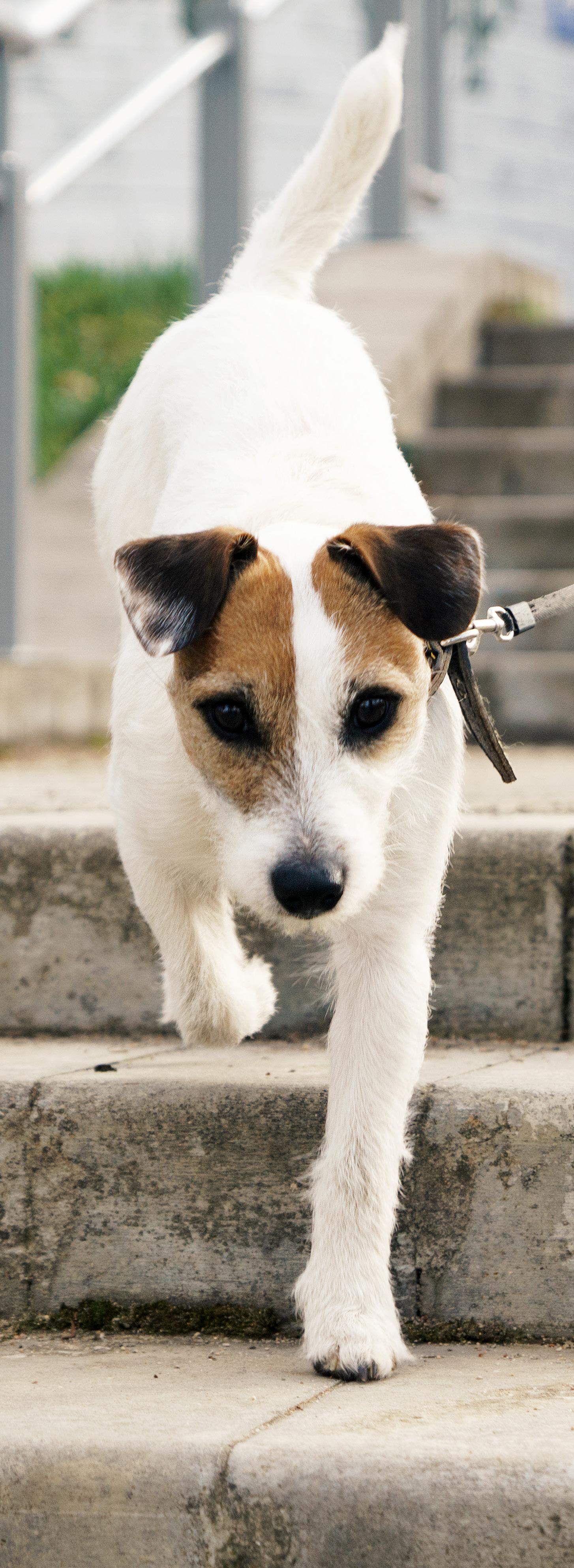
DQ | 3C 56
If one does not have access to much equipment, or your space is limited, these tips could come in handy:
• For cavalettis/poles to step over: if you do not have poles, use brooms or mops. For smaller dogs, simply laying a hosepipe in an S-shape creates a row of ‘obstacles’ for your companion to step over

• For the incline and decline stands: if you do not have a platform to work on, simply use a step, bricks, or even books
• Laying out cavalettis or weaves down a passageway is a great way to encourage your companion to perform the exercise
• Make use of chairs to create a pathway or to create a barrier when doing exercises such as a sit to stand or backwards walking
• If you do not have a lilo, flat pillows or dog beds work, or even an air mattress
• Keep the sessions light and fun, ten to fifteen minutes is plenty
• Find the right motiviation - it might be treats, toys or praise and encouragement from you
• If your companion has no interest in exercising at home, try add some weaves or obstacles whilst out on a walk - be creative!
• Be aware of signs of fatigue or struggle, which mean your companion is finding the exercise too hard.
• Rest days are vital. Two or three sessions a week is enough for those who want to create a training schedule
As you try out some of the exercises we’ve discussed, please remember that these sessions should be fun and nothing should be forced. If you notice your companion struggling to perform or refusing to do a certain exercise, ask yourself why. Is he/she too weak to perform it? Is there something wrong that is stopping them from being able to perform it? These are the signs that your companion may need a check up and some professional input. The beauty of these exercises is that they provide you with an early warning system that something may be wrong or sore, so always take note when your companion starts struggling with an exercise they could previously perform.

And remember to have fun!!


ANIMAL HEALTH AND HYDRO RYNFIELD
154 President Brand Str, Rynfield, Benoni
Contact: 083 230 2188 Email: animalhealths@gmail.com
ANIMAL HEALTH AND HYDRO PRETORIA EAST
218 Mark St, Grootfontein County Estates, Pretoria East, Grootfontein Country Estates
Contact: 074 251 4410 Email: ahahpretoria@gmail.com
DEGENERATIVE MYELOPATHY

DQ | 3C 58 DOG HEALTH
DNA testing can identify the mutation in the gene.

A DEVASTATING SPINAL CONDITION
Degenerative myelopathy, commonly known as Degenerative Radiculomyelopathy (CDRM) is a spinal disorder most commonly affecting breeds like the German Shepherd. It has recently also been diagnosed in Corgis, Poodles, Pugs, Boxers, Rhodesian Ridgebacks and Retrievers, with the average age of onset of clinical signs occurring between 7 and 14 years of age.
59
DOG HEALTH
WHAT IS DEGENERATIVE MYELOPATHY?
Degenerative myelopathy is a neurological condition that slowly progresses over several months (usually 12-18 months from the first onset of signs). In this condition, the nerves of the spinal cord gradually lose their myelin coating (demyelinate), which reduces their ability to transmit nerve impulses. The condition generally begins in the middle of the back and then spreads throughout the rest of the spine. It is not, in itself, painful but will gradually result in complete hind limb paralysis.
The cause of the condition is not fully understood, but there does seem to be a genetic link involved. The link comes in the form of a mutation in the gene coding for superoxide dismutase, a protein responsible for destroying free radicals in the body. Free radicals are needed as part of a natural defence system in the body but can become harmful when produced in excessive
quantities. In excess, they can cause cell death and degenerative diseases. It seems that inheriting one copy of the mutated gene from the father and one from the mother is strongly associated with the development of degenerative myelopathy. However, having two copies does not necessarily always result in clinical disease, and similarly, an absence of the gene mutation does not guarantee that the condition will not occur. Interestingly, the same gene mutation is also found in a form of motor neuron disease in humans.

DQ | 3C 60 DOG HEALTH
Degenerative myelopathy sees the myelin coating of the nerve break down. Myelin is critical for efficient transmission of nerve signals.
CLINICAL SIGNS OF THE DISEASE
Clinical signs of degenerative myelopathy include:
• General weakness in the hind limbs
• Scuffing of nails caused by dragging of the paws
• Stumbling, especially on slippery surfaces
• Ataxia (a wobbly and uncoordinated gait), particularly in the hind limbs
• Muscle atrophy over the hind limbs
• Delayed proprioception (i.e. delayed ability to sense where the limbs are)
• Incontinence
• Hind limb paralysis
DIAGNOSIS
Your vet will examine your dog and investigate to rule out other causes of the symptoms, like a slipped disc. In some cases, your dog may be referred to a neurology specialist for further tests and confirmation of the diagnosis.
TREATMENT
With the condition being progressive and damage being irreversible, there are, unfortunately, no current surgical options available. Owners whose dogs have been diagnosed

can therefore only provide support to their companion and give them a good quality of life for as long as possible. Complementary therapies can aid in improving quality of life and include:
• Massage therapy eases any compensation over the forelimbs caused by the shoulder muscles becoming tense from having to do extra work and also helps to ease tension in the lower back, as this area is put under stress when the hind limbs are failing.
• Hydrotherapy helps mobility and provides non-weightbearing exercise to encourage muscle tone to remain as high as possible for as long as possible. It also helps to promote normal limb placement.
Other ways to help a dog with degenerative myelopathy include:
• Providing softer bedding for greater support.
• Using paw boots to protect the feet, especially the hind limbs.
• Using a harness for extra support when walking.
• Controlling the weight of the dog to avoid unnecessary stress on the body.
DQ | 3C 61 DOG HEALTH
Some companies make braces and even carts with wheels for dogs with the condition.
SLEEPING LIE LET DOGS
UNDERSTANDING SLEEP IN OUR CANINE COMPANIONS

DQ | 3C 62 DOG HEALTH
Sleep is just as important for our dogs as it is for us. Adult dogs need in the region of 16 hours of sleep a day, with puppies and larger breed dogs needing as much as 20 hours a day. In dogs, just as in humans, there is a strong correlation between well-being (both physical and mental) and sleep.
THE DIFFERENCES BETWEEN HUMAN AND CANINE SLEEP

Humans are monophasic sleepers, which means that we generally take all our sleep in one go, while our dogs are polyphasic, meaning they sleep for shorter periods but at many different points during a twenty-four hour period. Both slow-wave sleep (the sleep of the brain) and REM sleep (the sleep of the body, which paralyses the postural muscles) are necessary for both dogs and humans, but a dog can reach REM sleep much more rapidly.
A NORMAL CANINE SLEEP ROUTINE
A normal sleep pattern for a dog is to sleep, wake up, have a stretch, find a more comfortable position and then go back to sleep. This regular shifting between sleep and wakefulness does not affect the quality or quantity of sleep and should be a normal part of a dog’s life.
Another point to note is that dogs are predominantly nocturnal. This is evidenced by wild canids and wolves that evolved to hunt in low light conditions at dawn and dusk, where there was no need to differentiate between bright colours, as everything has a grey hue. Dogs today, despite evolution, still see only muted colours in line with being nocturnal like their ancestors. To further support this, some domestic dogs will still show nocturnal wakefulness, and this is particularly the case in young puppies. They are often up and raring to go just as their human is winding down to sleep!
WHY IS SLEEP SO CRITICAL
DID YOU KNOW?
Letting your dog sleep in your bed is of huge benefit to both you and your dog!
Sleep is integral for many reasons, including helping to consolidate memories, promoting healing and helping to restore and rejuvenate the immune system. Sleep also has a sizeable effect on cognitive abilities. Without the right amount of sleep, the body cannot repair itself as easily, and the ability to learn is diminished. Other downsides of decreased sleep are the inability to regulate body temperature, less interest in body care, and a tendency to be overreactive – noises and weird shapes suddenly appear scary, and ‘spookiness’ is not uncommon.
DQ | 3C 63 DOG HEALTH
OUR ROLE
Because we control so much of our dogs’ lives, we must be especially aware of how much they sleep. We need to know what can cause issues with sleep and how we can best promote sleep in our canine companions.
WHAT PREVENTS DOGS FROM GETTING THE RIGHT AMOUNT OF SLEEP?

One of the most common reasons for a dog not receiving enough sleep is overstimulation. Our dogs usually enjoy getting out and about as much as we do, but there are limits as to how much a dog can cope with before he becomes exhausted and frustrated.
The result of continually overstimulating your dog is a dog who is restless, fidgety and unable to settle. This behaviour does not suggest an increased need for exercise but rather an increased need for rest. More exercise will simply produce more adrenaline, and make it more difficult for your dog to sleep. This is why it is essential that your dog has plenty of downtime to facilitate relaxation and allow sleep.
HOW TO IMPROVE SLEEP?
It is important that there are beds in several areas of the house, so a dog can choose where he wants to sleep. If the only bed is in an area like a busy kitchen, a dog will be continually disturbed and unlikely to be able to rest or sleep.
DQ | 3C 64 DOG HEALTH
Similarly, if the only bed is out of reach of the family, your dog is unlikely to use it as he would prefer not to be isolated. Where there are multiple dogs in one household, dogs should not be expected to share beds; they may choose to, but they should always have the option of having their own bed. Finally, dogs should have beds large enough for them to be able to lie flat; otherwise, they cannot reach REM sleep. Hard-sided round beds can be problematic if they force your dog to roll into a ball, as this prevents REM sleep from being achieved. Sleep disturbances can also occur due to the presence of pain or other serious health conditions such as arthritis, anaemia, heart disease and canine cognitive dysfunction, which are all common as a dog ages. If you are concerned
that health worries are preventing your dog from sleeping, see your vet as soon as possible.


Stress is another factor that can reduce the amount and quality of sleep your dog receives. Make sure to consider this option and see what you can do to minimise stress levels for your dog in the home.
Hunger and temperature extremes can also disrupt sleep, so it is worth making sure your dog is getting enough food to be satisfied at night and that he isn’t too hot or too cold. You must also ensure your dog doesn’t have to go for hours without visiting a toileting area.
Finally, you should avoid disturbing your dog when he is asleep – as the saying goes, ‘let sleeping dogs lie!’
DQ | 3C 65 DOG HEALTH
YOUR DOG QUESTIONS ANSWERED
Some dogs are just born loving water, and while whether or not your dog likes water is largely due to his personality, some of the preference is tied to his genetic make-up.
Some breeds of dogs love water because they were originally bred to be used for water activities. Some of these breeds have even developed physical characteristics that serve them well in the water. For example, Labrador Retrievers have more

Some of the top water-loving dog breeds include the Labrador Retriever, the Golden Retriever, the Standard Poodle, the Newfoundland and the German Shorthaired Pointer. Dog breeds that are less likely to love water include the brachycephalic breeds, as their flat faces make it more difficult to breathe when swimming, or dogs whose body types make staying afloat more difficult.
Having said this, each dog is different and whether or not your pooch likes to swim ultimately depends on his unique personality!
DQ | 3C 66
?
Itching and scratching excessively is not normal dog behaviour and indicates an abnormal response in your dog's body to certain allergens. Most commonly, these allergens are in the environment, but sometimes they can occur due to specific foods.

The scratching, due to the itch, can lead to dry skin on dogs and other irritations, making their skin look red or flaky. Regardless of how skin allergies present, it is usually a very uncomfortable condition for your dog that may keep them up through the night. Fortunately, with the right combination of dog food and medication, you can get your dog back on the right path to less itching and healthy skin.
IDENTIFYING THE ALLERGEN
One of the most challenging aspects is identifying the environmental allergen that is causing their reaction. Common causes of skin allergies in dogs include grass, pollen, dust mites and fleas. Unfortunately, all of these allergens are difficult to avoid. Still, the issue can be addressed with multimodal treatment consisting of medication to help reduce the immediate symptoms and nutrition for effective long-term care.
SPOTTING THE SYMPTOMS
Dry, itchy skin is just one symptom that indicates your dog is reacting to an environmental allergen. Other symptoms include red patches, spots, pimples, flaky or scaly patches, hair loss, scabs, crusts, thickened skin, itching, scratching, licking, rubbing, bad skin odour, digestive issues, watery eyes or a runny nose.
MANAGING ALLERGIES
Understanding how to help dogs with dry skin and other allergic issues can feel frustrating, and treatment can vary case-by-case depending on your dog's diagnosis. However, in general, a combination of therapeutic nutrition and veterinarian-prescribed medication can help prevent future flare-ups of allergies.
NOTE: Whilst it is common to feel a little frantic when your pet is itching uncontrollably, it is best to call your vet rather than reach for endless home remedies and shampoos. Your vet will be able to prescribe certain medications that will give fast relief. Topical remedies can be beneficial, but tend to act much slower and provide shorter-term relief, and there is always a risk that the topical remedy makes the situation worse.
DQ | 3C 67 Q&A
What is an environmental allergy in a dog?
DID YOU KNOW?
Mother dogs will sometimes eat their puppies' faeces. This is probably a residual wild instinct, as eating the faeces in the wild would help a dog to hide her puppies' existence from predators.
Why does my dog eat poo?
Coprophagia (the technical term for the consumption of faeces) is unpleasant but not uncommon behaviour among dogs. The good news is that eating faeces generally isn't harmful to your dog but is, of course, pretty gross and gives your dog particularly heinous breath. There is also a risk of acquiring parasites if your dog eats faeces from other animals.
Nobody is entirely sure why dogs eat faeces, but there are a couple of possible theories. Firstly, it may simply be that some dogs enjoy it. Dogs interact with the world through their mouths, and it is possible that dogs like examining faeces with their mouths. Dogs also enjoy things that have strong smells, and faeces certainly fit the bill here.
Secondly, puppies are known to sometimes eat their own poo when they are young. This usually occurs
during toilet training because they are still uncertain about where they are supposed to defecate and where they are not supposed to defecate. Afraid they may have done something wrong, they 'hide the evidence' by eating their faeces. This kind of 'cleaning up' behaviour can also happen with adult dogs inside the house.
Another common reason given for coprophagia is dietary deficiencies. For instance, eating the faeces of herbivores such as horses may provide vitamins that aren't part of your dog's regular diet. Similarly, cat food is high in protein, so cat litter may prove appealing. However, it is important to curb this behaviour immediately, as cat litter can be toxic to dogs.
The easiest way to deal with the issue is simply to pick up your dog's faeces as soon as they are produced. If the habit concerns you or is new, it is worth chatting with your vet to see if they can offer any suggestions or identify any particular deficiencies in your dog's diet.

DQ | 3C 68
If you want to advertise with us, please contact Dr Lizzie Harrison info@dqmagazine.co.za

Products we love
Shopping fun
PaleoPet Pure THERAWPY Duck, Pear and Ginger Meal for Dogs

This is a power packed and highly palatable product with pear and organic ginger! Pear contains pectin which aids digestion and ginger is not only a digestive aid, but also contains minerals like manganese, which is necessary for cruciate tendon health.
This product is lower in protein, fat and phosphorus than our PaleoPet Pure Classic Complete Meals, and so is ideal for older dogs requiring a bit more fibre and some digestive help, or dogs with liver or kidney issues.
As this product contains only duck protein, it is a great alternative for dogs with chicken allergies.
As with all PaleoPet Pure Complete meals a
healthy dose of Omega 3 from sustainably sourced phytoplankton is added, along with Kelp and Vitamin E. The PaleoPet Pure range is FSA Food Safety certified and DALRRD registered. All products are produced using human food grade ingredients in an Audited Food Safe Facility.
Available in convenient, pre-frozen 1.5kg and 750g tubs or as a box of 12 individually wrapped 100g patties. The tubs are re-usable, recyclable and PBA-free.
Products can be purchased online at www.paleopetpure.com or at selected retailers.
DQ | 3C 70
No more overheating! For pets that want to chill out!
These fruity designed cooling mats are made to keep pets cool and comfortable on hot summer days. Activated by the weight of your pet, this mat will maintain a temperature slightly lower than the ambient for up to three to four hours of constant use. It automatically recharges itself as the pet moves. They are ideal for day to day use in beds, crates, kennels and to help your dog to stay comfortable when travelling in the car.
Visit www.mcmac.co.za for more information as well as other products available in our Rosewood Chillax Cooling range.
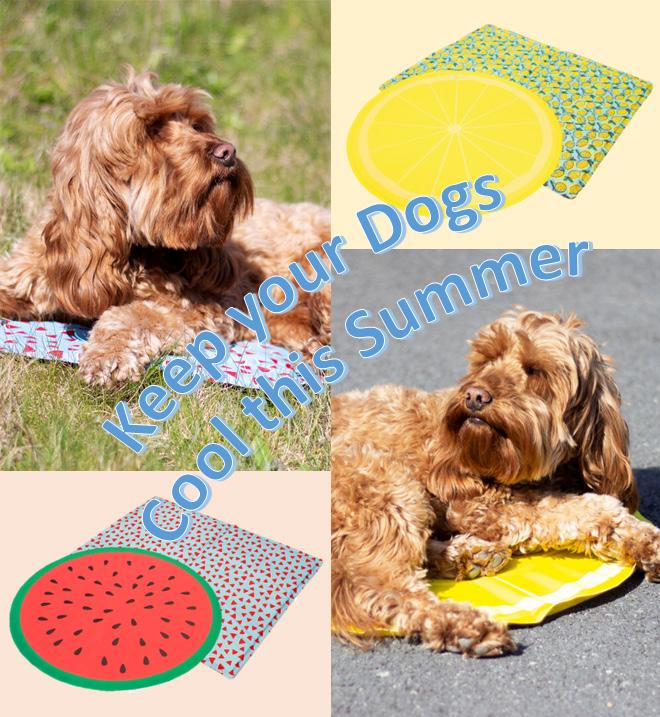
DQ | 3C 71
DQ | 3C 72 NEXT ISSUE 15TH DECEMBER 2022 www.dqmagazine.co.za
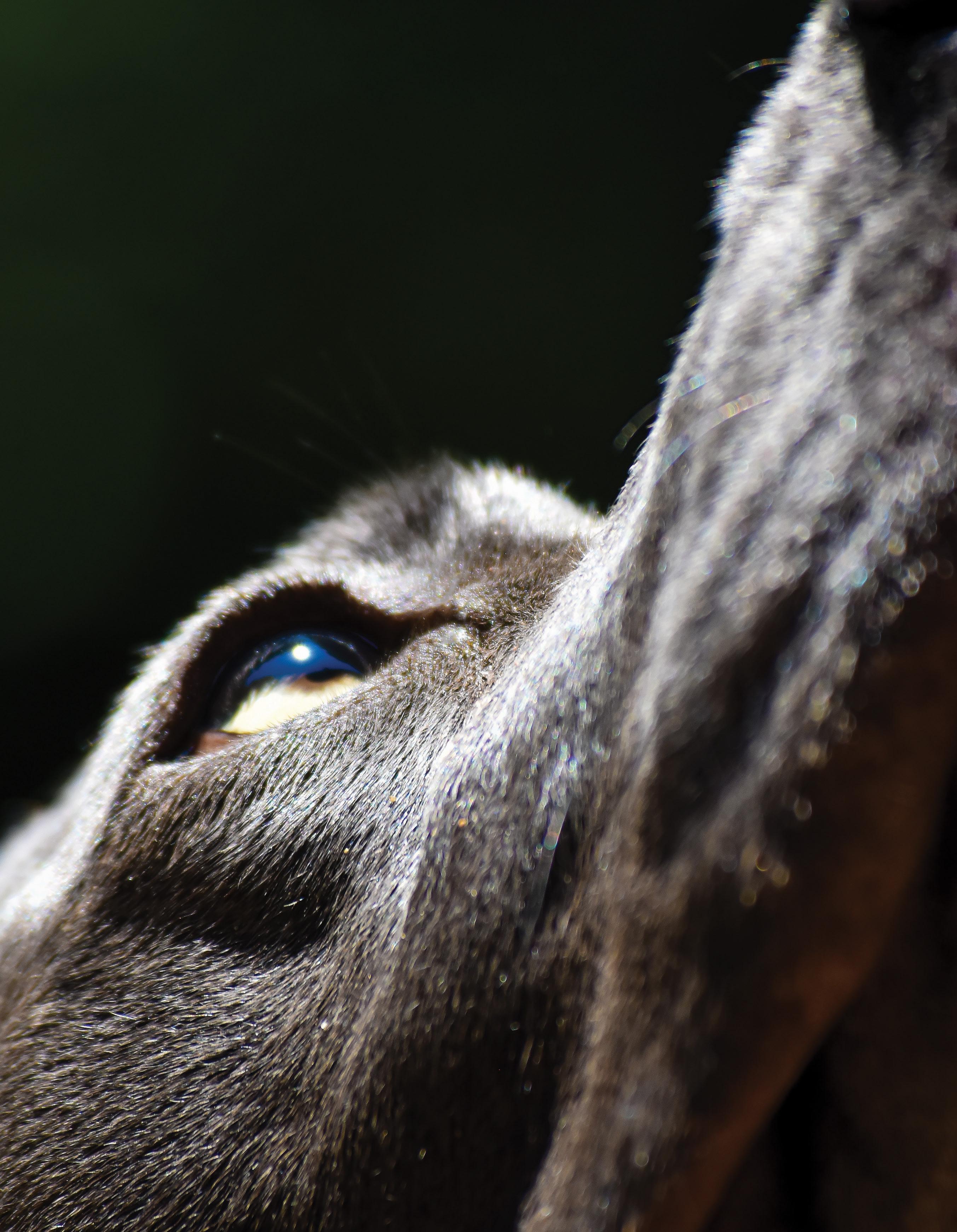
















































































































 TEXT: RHIANNON CECIL
TEXT: RHIANNON CECIL






























 Text | Bianca Rootman
Text | Bianca Rootman
























